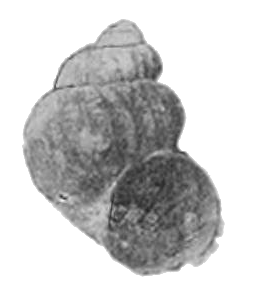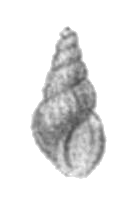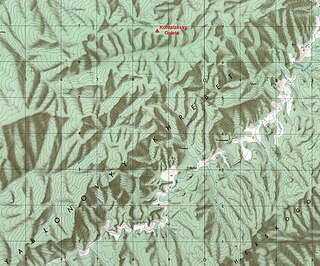
Lake Baikal is a large rift lake in Russia. It is situated in southern Siberia, between the federal subjects of Irkutsk Oblast to the northwest and the Republic of Buryatia to the southeast.

Hydrobiidae, commonly known as mud snails, is a large cosmopolitan family of very small freshwater and brackish water snails with an operculum; they are in the order Littorinimorpha.

Lymnaeidae, common name the pond snails, is a taxonomic family of small to large air-breathing freshwater snails, aquatic pulmonate gastropod mollusks, that belong to the clade Hygrophila.

Acroloxidae, commonly known as river limpets, are a taxonomic family of very small, freshwater snails, aquatic pulmonate gastropod limpet-like mollusks with a simple flattened conical shell in the clade Hygrophila.

Lithoglyphus naticoides, the gravel snail, is a species of small or minute freshwater snail with an operculum, an aquatic gastropod mollusk in the family Lithoglyphidae.

Theodoxus fluviatilis, common name the river nerite, is a species of small freshwater and brackish water snail with a gill and an operculum, an aquatic gastropod mollusk in the family Neritidae, the nerites.

Lithoglyphidae is a family of small freshwater snails with gills and an operculum, aquatic gastropod mollusks.

Aleksei Alekseevich Korotnev was a Russian zoologist.
Benedictia is a genus of freshwater snails with an operculum, aquatic gastropod molluscs or micromolluscs in the family Lithoglyphidae.
Kessler's sculpin is a species of Baikal sculpin, a freshwater fish native to Russia and Mongolia where it occurs in Lake Baikal and surrounding lakes as well as the Selenga, Angara and Bain Gol rivers. It is the only member of its genus. In Lake Baikal it occurs on sandy, rocky-sandy or sandy-muddy bottoms, ranging from relatively shallow water to depths of 70 m (230 ft). In rivers they mainly occur in slow-flowing channels and floodplains.
The stone sculpin is a species of cottoid fish endemic to Russia, where it is found in Lake Baikal and surrounding tributaries as well as the Gramninskie Lakes, Lake Verkhnaya Agata and the Enisei River and various lakes in Tuva. This species is the only recognized member of its genus.
Procottus jeittelesii, the red sculpin or red Baikal sculpin, is a species of ray-finned fish belonging to the family Cottidae, the typical sculpins. This species is endemic to Lake Baikal in Russia. It is a freshwater fish that dwells under stones or in holes in the mud at a depth range of 0 to 800 m. It is often found at around 100 m (330 ft), and is most abundant during the autumn and winter. From the late winter to the spring it breeds at depths of 5 to 30 m. It can reach a maximum length of 18 cm (7.1 in), but typically is 10–12 cm (3.9–4.7 in). It has a red spotted or banded pattern on a light background. The red sculpin resembles two of its close relatives, the smaller P. gurwici and the larger P. major.
Megalovalvata baicalensis is a species of freshwater snail with an operculum, an aquatic gastropod mollusk in the family Valvatidae, the valve snails.
Parafossarulus sungariensis is a species of freshwater snail with gills and an operculum, an aquatic prosobranch gastropod mollusk in the family Bithyniidae.

Choanomphalus is a genus of air-breathing freshwater snails, aquatic pulmonate gastropod mollusks in the family Planorbidae, the ram's horn snails, or planorbids. All species in this genus have sinistral or left-coiling shells.

Choanomphalus maacki is a species of freshwater air-breathing snail, an aquatic pulmonate gastropod mollusk in the family Planorbidae, the ram's horn snails, or planorbids.

Choanomphalus amauronius is a species of freshwater air-breathing snail, an aquatic pulmonate gastropod mollusk in the family Planorbidae, the ram's horn snails, or planorbids.

Teratobaikalia macrostoma is a species of a freshwater snail with an operculum, an aquatic gastropod mollusk in the family Amnicolidae.

Maackia raphidia is a species of freshwater snail with an operculum, an aquatic gastropod mollusk in the family Amnicolidae.

Kontalaksky Golets is a peak in the Yablonoi Mountains. Administratively it is part of Zabaykalsky Krai, Russian Federation.











